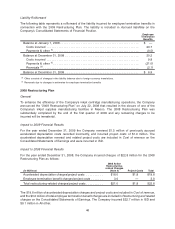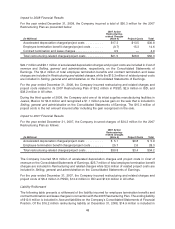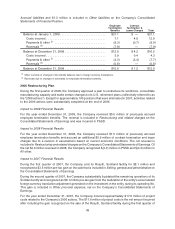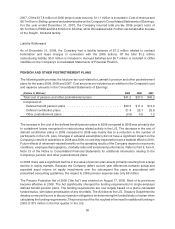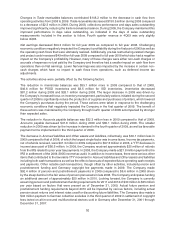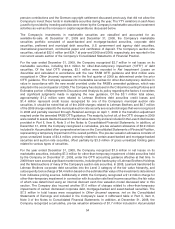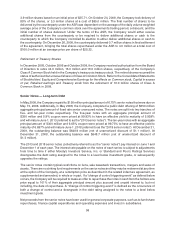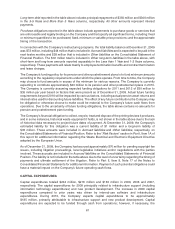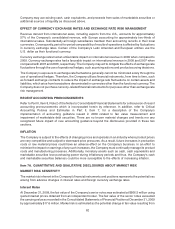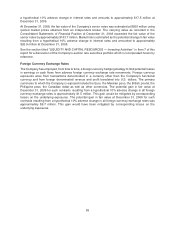Lexmark 2009 Annual Report Download - page 62
Download and view the complete annual report
Please find page 62 of the 2009 Lexmark annual report below. You can navigate through the pages in the report by either clicking on the pages listed below, or by using the keyword search tool below to find specific information within the annual report.For year-end 2009, the Company’s auction rate securities for which recent auctions were unsuccessful
were valued using a more refined discounted cash flow model that places greater emphasis on the
characteristics of the individual securities, which the Company believes yields a better estimate of fair
value. The first step in the valuation included a credit analysis of the security which considered various
factors including the credit quality of the issuer (and insurer if applicable), the instrument’s position within
the capital structure of the issuing authority, and the composition of the authority’s assets including the
effect of insurance and/or government guarantees. Next, the future cash flows of the instruments were
projected based on certain assumptions significant to the valuation including (1) the auction rate market
will remain illiquid and auctions will continue to fail causing the interest rate to be the maximum applicable
rate and (2) the securities will not be redeemed. These assumptions resulted in discounted cash flow
analysis being performed through the legal maturities of these securities, ranging from the year 2032
through 2040, or in the case of the auction rate preferred stock, through the mandatory redemption date of
year-end 2021. The projected cash flows were then discounted using the applicable yield curve, such as
AAA or AA US Muni Education Revenue curve for student loan auction rate securities, plus a 250 basis
point liquidity premium added to the applicable discount rate of all but one auction rate security. For this
instrument, developments in the fourth quarter of 2009 raised serious concern regarding the insurer’s
ability to honor its contract. Given the distressed financial conditions of both the issuer as well as the
insurer, the fair value of the municipal bond was primarily based on the expected recoveries that holders
could realize from bankruptcy proceedings after a likely work out period of two years. A small number of
comparable trades were also considered in the valuation of this instrument which supported the discount
rate applied. Overall, the auction rate security portfolio balance decreased $2.7 million during 2009 and
was largely due to the $0.7 million decrease in the fair value of this security as well as higher liquidity
premiums and longer economic maturities based on the Companies assumptions regarding the auction
rate market compared to those of 2008. For comparison purposes, a summary of the year-end 2008
valuation techniques and assumptions used to measure auction rate securities is provided in the following
paragraph.
The Company performed a discounted cash flow analysis on its auction rate securities at year-end 2008,
using current coupon rates, a first quarter 2010 redemption date and a 50 basis point liquidity premium
factored into the discount rate. The result was a downward YTD mark to market adjustment of $2.5 million
in 2008, of which $1.9 million was recognized in the Consolidated Statements of Earnings as other than
temporarily impaired due to credit events related to the municipal auction rate security discussed in detail
above. The remaining $0.6 million was recognized in Accumulated other comprehensive loss on the
Consolidated Statements of Financial Position representing the mark to market adjustment on all other
auction rate securities.
Refer to Part II, Item 8, Note 3 of the Notes to Consolidated Financial Statements for additional information
regarding fair value measurements, including the techniques used to value the Company’s remaining
Level 3 securities not discussed above. Refer to Part II, Item 8, Note 6 of the Notes to Consolidated
Financial Statements for additional information regarding marketable securities.
In addition to investments in marketable securities, the Company also invested $242.0 million,
$217.7 million and $182.7 million into Property, plant and equipment for the years 2009, 2008 and
2007 respectively. Further discussion regarding 2009 capital expenditures as well as anticipated spending
for 2010 are provided near the end of Item 7.
Other notable investing cash flows for 2009 included the acquisition of a wholesale company for
$10.1 million, net of cash acquired. The wholesaler was purchased for its current customer base and
established presence in Eastern Europe. The acquisition was not a significant business combination.
Refer to Part II, Item 8, Note 3 of the Notes to Consolidated Financial Statements for additional information.
Proceeds from sale of facilities includes $4.6 million received from the sale of the Company’s inkjet
supplies assembly plant located in Juarez, Mexico in 2008 as well as $8.1 million received from the sale of
the Scotland facility that occurred in 2007, both of which were part of the Company’s restructuring actions.
56


